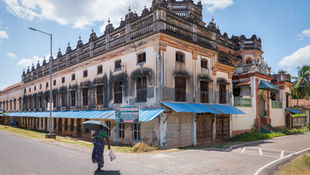Interior views add valuable information to the documentation of a historic building. To capture the true essence of the building, the following photographs should be taken of the interior of most historic buildings: Firstly, the overall views of important interior rooms must be taken to capture the entire space, such as courtrooms, historic kitchens, etc. Secondly, views of important interior features must be taken, like staircases, fireplaces, ceilings, exposed structural framing, etc. After which comes capturing the significant interior details, such as wood carving details, metalwork, plasterwork, ceiling details, constructional details, doors, artwork, door hardware, wall paintings, inscriptions, light fixtures, industrial machinery, etc. Finally, the views of people using the building should be part of the frame.

List of Contents
The Use of Natural Light
While photographing the interior spaces, the ones that are exposed in the shadows are the ones that are internally lit. Effectively used lighting and clear detail make the photograph an adequate record. Daylight illumination is frequently inadequate for interior photography, so additional artificial lighting has to be used.

Passageways
The kind of passageways and their position in the early houses provide important hints to understand the type of building development. It is necessary to show the relationship between passageways and internal and external doorways.


Staircases
A simple, straightforward photograph of a staircase usually contains most of the information. A straight-on architectural viewpoint with the balusters in profile clearly relates the various levels of a staircase. Looking down on the staircase produces an interesting but inadequate photographic recording in which very little architectural information is shown. Details of the handrail, balustrades, newel post, floor, etc., should be taken.


Woodcarving Details
The lighting of carved-wood details is often easier to control than larger areas of dark panelling. Free-standing subjects can be lit from several directions: one from the background to give an even illumination, one from behind the subject to give shadow relief and highlights, and one from the camera position to soften the shadow contrast.
A wide aperture is used to separate the subject from the background, and the flashguns are held higher than the subject to create a natural shadow effect. The light falling on a subject taken in front of the camera will project the shadow back towards the camera, thus accentuating the carved relief. To avoid a flat light effect, the fill-in light from the camera position should be further from the subject than the shadow-producing backlight. Carved forms can be lit by multiple flashes of light to create soft lighting that reveals details. It can also be done using a strong sidelight to show the design and depth of the carving. When photographing, straight-on panels in relief can be lit by one light outside the reflective area and far enough away to provide illumination.



Metalwork
Daylight gives the most natural appearance to polished metalwork. A large aperture combined with a close viewpoint prevents reflected images from being too sharply defined and also helps to separate the subject from its background. Where the metal surface reflects light unevenly, additional highlights can be introduced in the form of white reflective surfaces.
A delicately carved baluster can be given diffuse lighting to reveal its tracery. A greater level of illumination in the background will show the balusters in silhouette but without deep shadow. The balusters can be defined by the use of strong side-lighting to emphasise detailed casting; the light and dark sides of the uprights will have greater tonal extremes than the mid-tone of the background.

Plaster-work
To record a ceiling motif, the camera can be placed on the floor beneath the central point; the camera has to be carefully levelled to prevent distortion. The use of reflected or very diffused lighting is the only way to avoid shadows from a pendant light fixture. To prevent excessive shadow, ceilings with gilded and painted decoration in relief can be illuminated entirely by artificial light reflected off of adjacent walls.

Wall Paintings
Wall paintings need recording in colour and black-and-white. Details of the original technique and current deterioration in the painting should also be recorded. A varnished or glossy surface can produce a reflected glare if direct lighting from the camera position is used carelessly.

Points to Note While Photographing the Interiors
Make use of natural light or supplementary lights like a flash.
Interior photography is all about making sure the captured image has horizontal and vertical lines. These lines should not be distorted; otherwise, the overall composition will be ruined. The accessories and furniture must also be considered for a straight and balanced composition.
The room to be photographed should be kept neat and tidy.
The space provided must be used creatively and effectively without compromising the photograph. For instance, a small room can be photographed by positioning the camera in an adjacent hall.
Conclusion
Photographing the interiors of a historic building is quite different from photographing the building's exterior. One must understand the importance of the interiors without missing any important aspect. Unlike exterior photography, interior photography does not look at the bigger picture or context. It focuses on one space or a detail that depicts the character of the building. Balance and composition are aspects that should be taken seriously while taking interior photography, and the lines must be parallel or perpendicular, not angular. Natural light also plays an important role, and the camera must be positioned such that the highlights and shadows properly fall on the space. Thus, interior photography can be used to narrate the lifestyle of the people who once resided in the historic building.
Visit the links given below, to read some of our blogs:















Komentarze